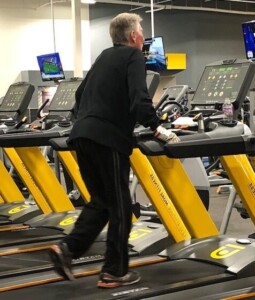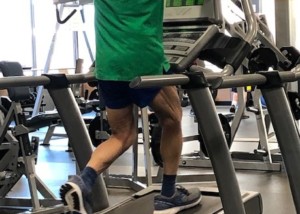
Some people use gloves when holding onto a treadmill, but there’s something they should know about this practice.
And that is:
It’s wrong. I don’t mean the part about using gloves to hold onto a treadmill. I mean the part about holding on, PERIOD. It’s wrong.
As a personal trainer, I forbid all of my clients from holding onto a treadmill.
The only exception was a 70-year-old man who needed a walker to get around anyplace, and I had him holding on—only as much as he absolutely needed to—to the side rails.
I eventually got him off the walker he’d been using for years and to a four-pronged cane—a step-up in control.
But when you see people wearing gloves while they hold onto a treadmill—these are able-bodied women and men, and the gloves are for increased traction or gripping efficiency.
A secondary reason might be to prevent their sweat from getting onto the rails, bar, or wherever they’re holding fast to.
You don’t need gloves to hold onto a treadmill, because you shouldn’t be holding on in the first place.
The exception is to place your hands on the machine to keep from falling off—WHEN you feel you’re about to lose your footing as a result of turning around to greet someone or a shoelace becomes untied.
Another valid reason is when you’re changing the settings, taking water or checking heart rate.
But these actions are transient, very temporary, so that when you’ve completed them, your hands should detach from the treadmill and move naturally.
Gloves can encourage tight holding, and I’ve actually witnessed this.
The user was a man, and his machine was set at 15 percent incline and 4 mph. Now that’s a pretty stiff setting, and if you try to walk this without holding on, you’ll end up stepping off the machine—unless you’re an Ironman athlete or experienced trail runner.
A smarter, more logical approach is to set the speed at 1.5 mph (yes, one and a half miles per hour) and keep your hands off.
Now before you laugh at this, ask yourself what speed you’d walk outside on a similarly inclined trail.
Think about this. You’d be moving at about 1.5 mph, maybe even slower. Imagine a very long stretch of inclined trail, extending endlessly up a mountain.
There is NO way you’d be booking up there at 4 mph—unless, as mentioned, you’re a veteran trail climber with very impressive fitness.
Go ahead, try it before you dismiss it: Walk 1.5 mph at 15 percent incline on a treadmill without any holding on. Go for 20 minutes.
I guarantee it, you’re going to feel a workout that you just won’t get with holding on at 4 mph.
This is because holding on, even at a fast speed, creates a fake movement pattern that’s based on external support. It doesn’t mimic the real thing.
The real thing—outside on a trail—comes without anything to hold onto. Now, fitter people will find that 1.5 mph doesn’t quite challenge them. If this describes you, try 2 mph.
If you can maintain a 2 mph walk at 15 percent without holding on—for 20 minutes—you’re in good shape. Don’t assume these slow speeds are too slow. Try them. For 20 nonstop minutes. No holding on.
The point at which holding onto a treadmill is necessary to prevent dropping off is not determined by a difference of one-tenth of a mile per hour.
I’m betting that you can handle something in between 1.2 and 1.5 mph, while at the same time, feeling a good workout.
There’s also a possibility that 1.2 mph will be too difficult for longer than 10 minutes or even five.
I’ve seen very poorly conditioned people doing the 4 mph, 15 percent, holding-on-with-gloves routine. Just one mph would exhaust them.
That’s okay – go to 0.8 mph, or lower the incline. It doesn’t have to be 15 percent, you know.
You should now know why you don’t need gloves to hold onto a treadmill.
A very slow pace, without holding on, delivers much better results and a far stronger training effect, than does holding on at fast speeds, even with gloves.
Once you’re off the treadmill—there’s nothing to grab onto. So how can holding on improve your fitness or balance? Or cause weight loss? Ditch the gloves and let go of the treadmill.

























